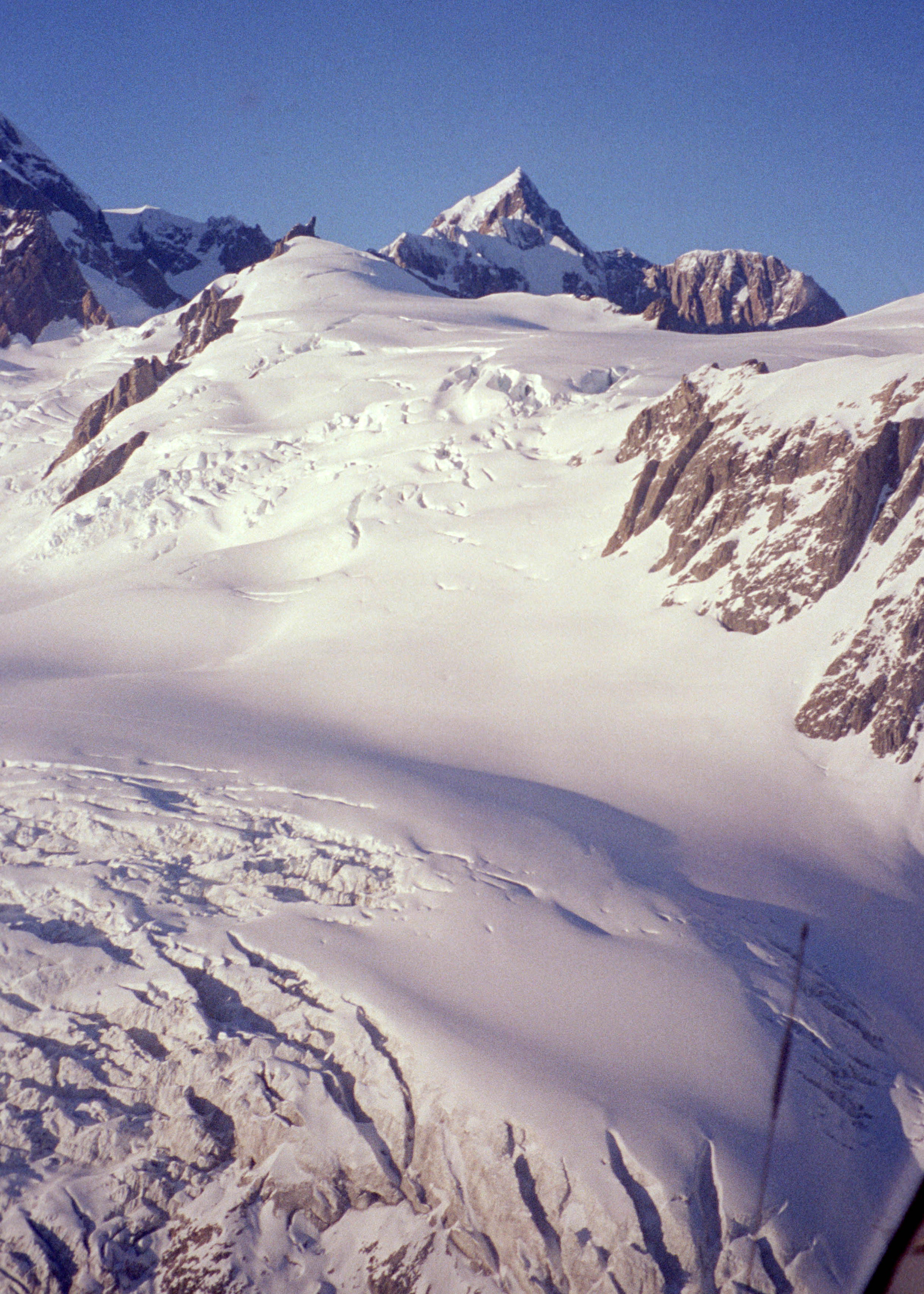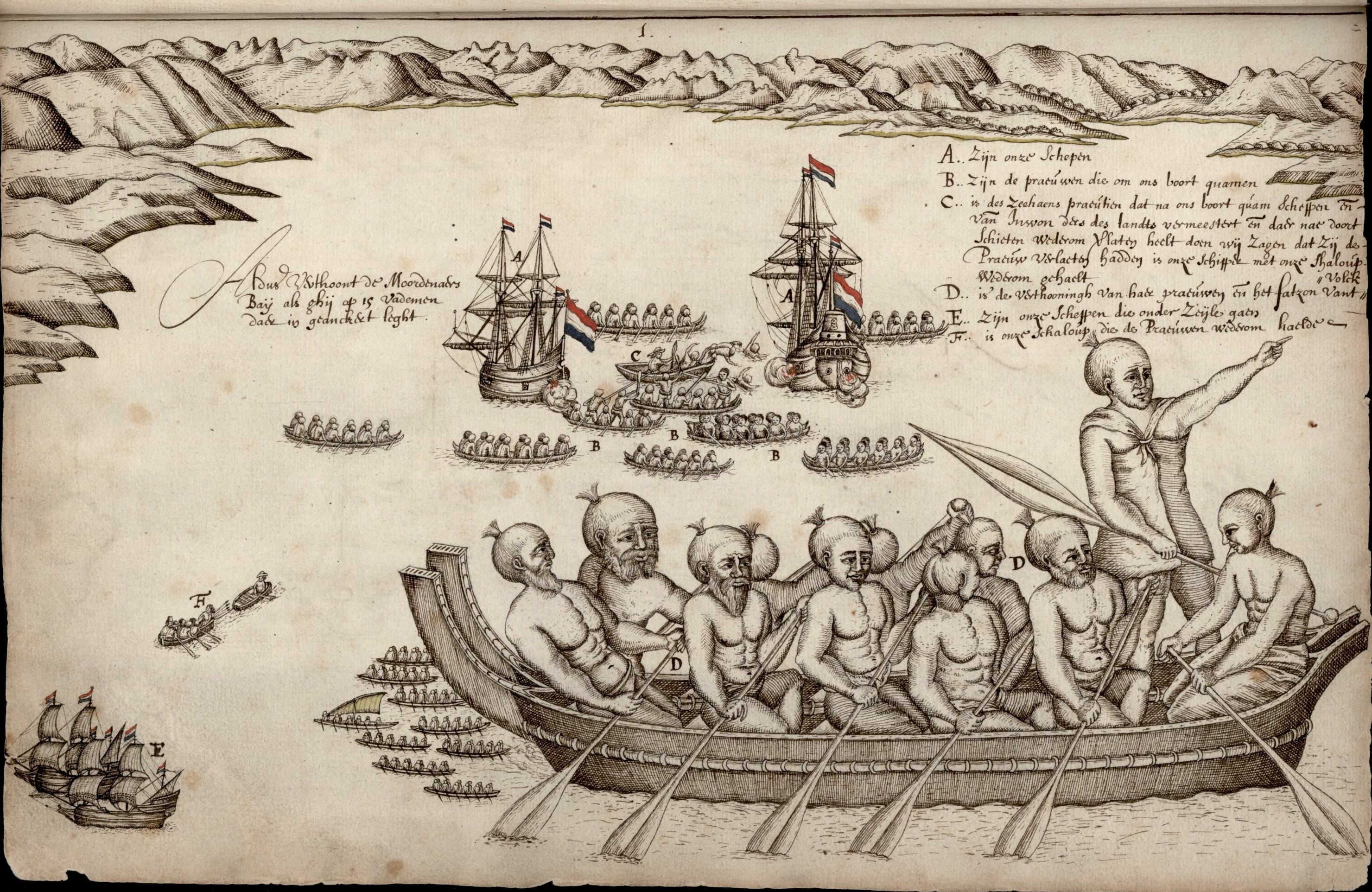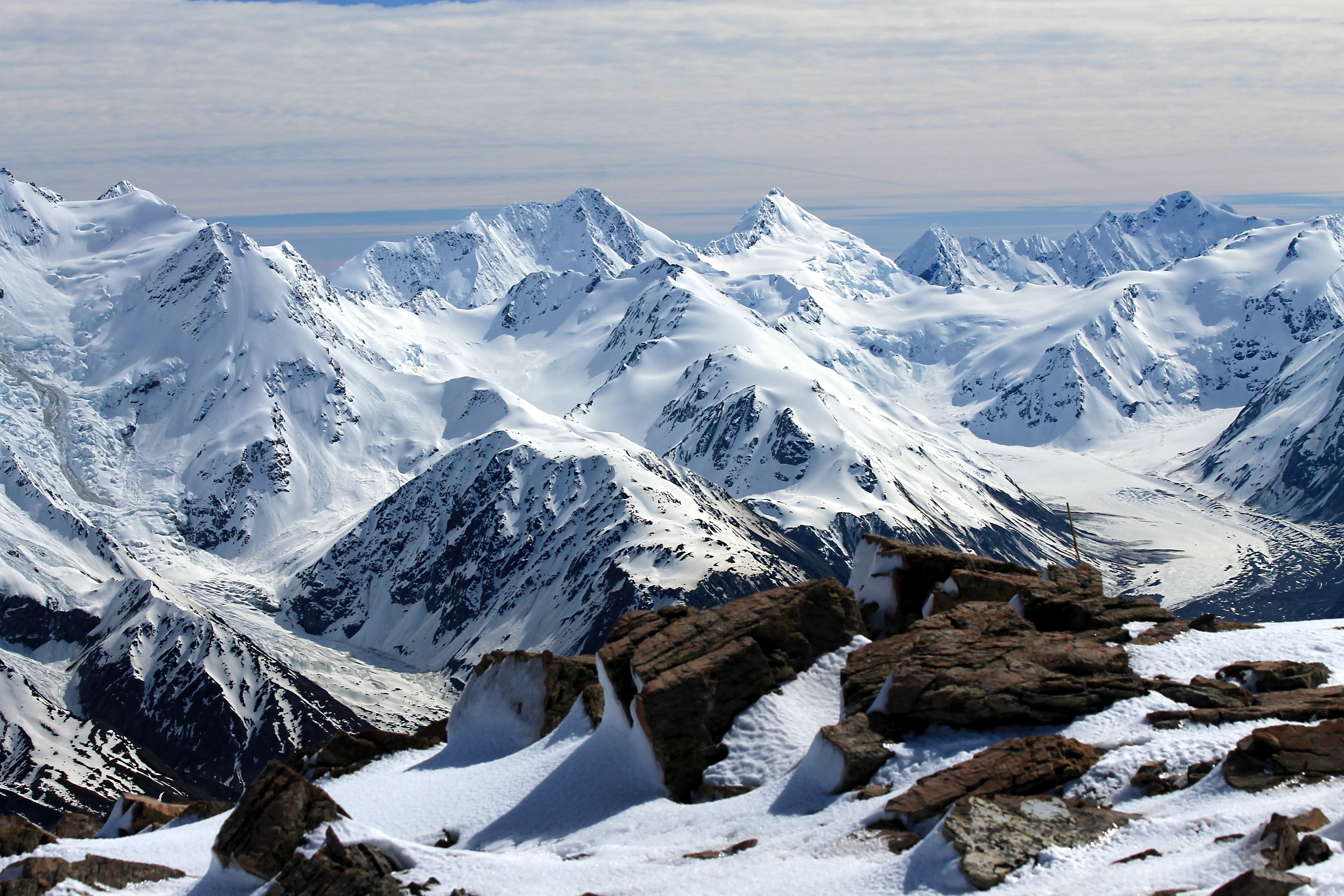|
Mount Cook Range
The Mount Cook Range (; officially gazetted as Kirikirikatata / Mount Cook Range) is an offshoot range of the Southern Alps of New Zealand. The range forks from the Southern Alps at the Green Saddle and descends towards Lake Pukaki, encompassing Aoraki / Mount Cook and standing adjacent to the Tasman Glacier Tasman Glacier (officially Haupapa / Tasman Glacier) is the largest glacier in New Zealand, and one of several large glaciers which flow south and east towards the Mackenzie Basin from the Southern Alps in New Zealand's South Island. Geography .... In 1889, the highest point of the range was , but this has since been reduced by avalanches and erosion. Naming In 2013, the range was officially renamed Kirikirikatata / Mount Cook Range as part of a number of name changes within the Mount Cook region, following a 2012 proposal. According to Māori creation myths, Kirikirikatata was the grandfather of Aoraki, both of whom turned into mountains; Kirikirikatata into the Moun ... [...More Info...] [...Related Items...] OR: [Wikipedia] [Google] [Baidu] |
Aoraki / Mount Cook
Aoraki / Mount Cook is the highest mountain in New Zealand. Its height, , is listed as . It is situated in the Southern Alps, the mountain range that runs the length of the South Island. A popular tourist destination, it is also a favourite challenge for mountaineers. Aoraki / Mount Cook consists of three summits: from south to north, the Low Peak (), the Middle Peak () and the High Peak. The summits lie slightly south and east of the main divide of the Southern Alps, with the Tasman Glacier to the east and the Hooker Glacier to the southwest. Mount Cook is ranked 10th in the world by topographic isolation. Location The mountain is in the Aoraki / Mount Cook National Park, in the Canterbury Region. The park was established in 1953 and along with Westland Tai Poutini National Park, Mount Aspiring National Park and Fiordland National Park forms one of the UNESCO World Heritage Sites. The park contains more than 140 peaks standing over and 72 named glaciers, which cover 40 p ... [...More Info...] [...Related Items...] OR: [Wikipedia] [Google] [Baidu] |
Land Information New Zealand
Land Information New Zealand (LINZ; ) is the public service department of New Zealand charged with geographical information and surveying functions as well as handling land titles, and managing Crown land and property. The minister responsible is the Minister for Land Information, and was formerly the Minister of Survey and Land Information. LINZ was established in 1996 following the restructure of the Department of Survey and Land Information (DOSLI), which was itself one of the successor organisations to the Department of Lands and Survey. The New Zealand Geographic Board secretariat is part of LINZ and provides the Board with administrative and research assistance and advice. The Minister for Land Information is Chris Penk. Gaye Searancke was appointed Chief Executive of Land Information New Zealand in August 2019. She succeeded Andrew Crisp, who had been in the post since 2016. Nature and scope of functions LINZ's purpose is to: *Maintain and build confidence in prop ... [...More Info...] [...Related Items...] OR: [Wikipedia] [Google] [Baidu] |
Māori Mythology
Māori mythology and Māori traditions are two major categories into which the remote oral history of New Zealand's Māori people, Māori may be divided. Māori myths concern tales of supernatural events relating to the origins of what was the observable world for the pre-European Māori, often involving gods and demigods. Māori tradition concerns more folkloric legends often involving historical or semi-historical forebears. Both categories merge in to explain the overall origin of the Māori and their connections to the world which they lived in. The Māori did not have a writing system before European contact, beginning in 1769, therefore they relied on oral retellings and recitations memorised from generation to generation. The three forms of expression prominent in Māori and Polynesian oral literature are genealogical recital, poetry, and narrative prose. Experts in these subjects were broadly known as . The rituals, beliefs, and general worldview of Māori society were ... [...More Info...] [...Related Items...] OR: [Wikipedia] [Google] [Baidu] |
Southern Alps
The Southern Alps (; officially Southern Alps / Kā Tiritiri o te Moana) are a mountain range extending along much of the length of New Zealand, New Zealand's South Island, reaching its greatest elevations near the range's western side. The name "Southern Alps" generally refers to the entire range, although separate names are given to many of the smaller ranges that form part of it. The range includes the South Island's Main Divide, which separates the drainage basin, water catchments of the more heavily populated eastern side of the island from those on the west coast. Politically, the Main Divide forms the boundary between the Marlborough Region, Marlborough, Canterbury Region, Canterbury and Otago regions of New Zealand, regions to the southeast and the Tasman Region, Tasman and West Coast, New Zealand, West Coast regions to the northwest. Names The Māori language, Māori name of the range is , meaning "the Fata Morgana (mirage), Mirage of the Ocean". The English people, ... [...More Info...] [...Related Items...] OR: [Wikipedia] [Google] [Baidu] |
Range (geographic)
A mountain range or hill range is a series of mountains or hills arranged in a line and connected by high ground. A mountain system or mountain belt is a group of mountain ranges with similarity in form, structure, and alignment that have arisen from the same cause, usually an orogeny. Mountain ranges are formed by a variety of geological processes, but most of the significant ones on Earth are the result of plate tectonics. Mountain ranges are also found on many planetary mass objects in the Solar System and are likely a feature of most terrestrial planets. Mountain ranges are usually segmented by highlands or mountain passes and valleys. Individual mountains within the same mountain range do not necessarily have the same Structural geology, geologic structure or petrology. They may be a mix of different orogenic expressions and terranes, for example Thrust fault, thrust sheets, Fault-block mountain, uplifted blocks, Fold (geology), fold mountains, and volcanic landforms result ... [...More Info...] [...Related Items...] OR: [Wikipedia] [Google] [Baidu] |
Green Saddle
Green is the color between cyan and yellow on the visible spectrum. It is evoked by light which has a dominant wavelength of roughly 495570 nm. In subtractive color systems, used in painting and color printing, it is created by a combination of yellow and cyan; in the RGB color model, used on television and computer screens, it is one of the additive primary colors, along with red and blue, which are mixed in different combinations to create all other colors. By far the largest contributor to green in nature is chlorophyll, the chemical by which plants photosynthesize and convert sunlight into chemical energy. Many creatures have adapted to their green environments by taking on a green hue themselves as camouflage. Several minerals have a green color, including the emerald, which is colored green by its chromium content. During post-classical and early modern Europe, green was the color commonly associated with wealth, merchants, bankers, and the gentry, while red was r ... [...More Info...] [...Related Items...] OR: [Wikipedia] [Google] [Baidu] |
Lake Pukaki
Lake Pukaki () is the largest of three roughly parallel alpine lakes running north–south along the northern edge of the Mackenzie Basin on New Zealand's South Island. The others are Lakes Tekapo and Ōhau. All three lakes were formed when the terminal moraines of receding glaciers blocked their respective valleys, forming moraine-dammed lakes. The Alps2Ocean mountain bike trail follows the edge of Lake Pukaki for part of its length. Geography The glacial feed to the lakes gives them a distinctive blue colour, created by glacial flour, the extremely finely ground rock particles from the glaciers. Lake Pukaki covers an area of , and the surface elevation of the lake normally ranges from above sea level. The lake is fed at its northern end by the braided Tasman River, which has its source in the Tasman and Hooker Glaciers, close to Aoraki / Mount Cook. To the west of Lake Pukaki lies the Ben Ohau mountain range with Ben Dhu () and Betty Hill () closest to the lake. On the ... [...More Info...] [...Related Items...] OR: [Wikipedia] [Google] [Baidu] |
Tasman Glacier
Tasman Glacier (officially Haupapa / Tasman Glacier) is the largest glacier in New Zealand, and one of several large glaciers which flow south and east towards the Mackenzie Basin from the Southern Alps in New Zealand's South Island. Geography At in length, Tasman Glacier is still New Zealand's longest glacier, despite shrinking considerably from the 1990s onwards. It is as much as wide and thick, and lies entirely within the borders of Aoraki / Mount Cook National Park. The glacier covers an area of and starts at a height of above sea level. Snowfall during the winter and spring seasons may accumulate up to . After the summer melt, may remain in the high altitude glacier head. The Tasman flows south west from Hochstetter Dome and Mount Elie De Beaumont alongside the southern slopes of The Minarets and south along the eastern flank of New Zealand's two highest mountains, Mount Tasman and its higher southern neighbour Aoraki / Mount Cook. Although its upper reaches ... [...More Info...] [...Related Items...] OR: [Wikipedia] [Google] [Baidu] |
Nazomi
Nazomi is a mountain in Canterbury, New Zealand. Description Nazomi is set in the Mount Cook Range of the Southern Alps of the South Island. This peak is located north of Mount Cook Village and set in Aoraki / Mount Cook National Park. Precipitation runoff from the mountain's west slope drains to the Hooker River, whereas the east slope drains to the Tasman River. Topographic relief is significant as the summit rises above the Hooker Glacier in two kilometres, and above the Tasman Glacier in four kilometres. The nearest higher neighbour is the Low Peak of Aoraki / Mount Cook, 1.5 kilometres to the north. Etymology The mountain's toponym was applied by Freda Du Faur when she climbed this peak on 12 March 1912. Nazomi is a Japanese word she thought meant "heart's desire", but which may better be translated as "wish, desire, or hope."''Du Faur ... [...More Info...] [...Related Items...] OR: [Wikipedia] [Google] [Baidu] |
Mount Rosa (New Zealand)
Mount Rosa is a mountain in Canterbury, New Zealand. Description Mount Rosa is set in the Mount Cook Range of the Southern Alps of the South Island. This peak is located north of Mount Cook Village and set in Aoraki / Mount Cook National Park. Precipitation runoff from the mountain's west slope drains into the Hooker River, whereas the east slope drains to the Tasman River. Topographic relief is significant as the summit rises above the Hooker Glacier in two kilometres, and above Tasman Lake in 2.5 kilometres. The first ascent of the summit was made in 1890 by Rosa Moorhouse and Mabel Studholme.''Mt Rosa'' New Zealand Alpine Club, Climbnz.org, Retrieved 16 February 2025. Etymology [...More Info...] [...Related Items...] OR: [Wikipedia] [Google] [Baidu] |
Mountain Ranges Of The Southern Alps
A mountain is an elevated portion of the Earth's crust, generally with steep sides that show significant exposed bedrock. Although definitions vary, a mountain may differ from a plateau in having a limited summit area, and is usually higher than a hill, typically rising at least above the surrounding land. A few mountains are inselberg, isolated summits, but most occur in mountain ranges. mountain formation, Mountains are formed through tectonic plate, tectonic forces, erosion, or volcanism, which act on time scales of up to tens of millions of years. Once mountain building ceases, mountains are slowly leveled through the action of weathering, through Slump (geology), slumping and other forms of mass wasting, as well as through erosion by rivers and glaciers. High elevations on mountains produce Alpine climate, colder climates than at sea level at similar latitude. These colder climates strongly affect the Montane ecosystems, ecosystems of mountains: different elevations hav ... [...More Info...] [...Related Items...] OR: [Wikipedia] [Google] [Baidu] |






